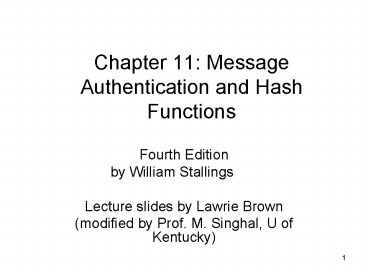Chapter 11: Message Authentication and Hash Functions - PowerPoint PPT Presentation
1 / 18
Title:
Chapter 11: Message Authentication and Hash Functions
Description:
... to message as a signature. receiver performs same computation on message and checks ... provides assurance that message is unaltered and comes from sender. 7 ... – PowerPoint PPT presentation
Number of Views:326
Avg rating:3.0/5.0
Title: Chapter 11: Message Authentication and Hash Functions
1
Chapter 11 Message Authentication and Hash
Functions
- Fourth Edition
- by William Stallings
- Lecture slides by Lawrie Brown
- (modified by Prof. M. Singhal, U of Kentucky)
2
Message Authentication
- message authentication is concerned with
- protecting the integrity of a message
- validating identity of originator
- non-repudiation of origin (dispute resolution)
- three alternative functions used
- message encryption
- message authentication code (MAC)
- hash function
3
Broader Set of Attacks
- disclosure
- traffic analysis
- masquerade
- content modification
- sequence modification
- timing modification
- source repudiation
- destination repudiation
4
Message Encryption
- message encryption by itself also provides a
measure of authentication - if symmetric encryption is used then
- receiver know sender must have created it
- since only sender and receiver now key used
- know content cannot of been altered
- Provides both sender authentication and message
authenticity.
5
Message Encryption
- if public-key encryption is used
- encryption provides no confidence of sender
- since anyone potentially knows public-key
- however if
- sender signs message using his private-key
- then encrypts with recipients public key
- have both secrecy and authentication
- but at cost of two public-key uses on message
6
Message Authentication Code (MAC)
- a small fixed-sized block of data
- depends on both message and a secret key
- like encryption though need not be reversible
- appended to message as a signature
- receiver performs same computation on message and
checks it matches the MAC - provides assurance that message is unaltered and
comes from sender
7
Message Authentication Code
8
Message Authentication Codes
- MAC provides authentication
- Message can be encrypted for secrecy
- generally use separate keys for each
- can compute MAC either before or after encryption
- is generally regarded as better done before
- why use a MAC?
- sometimes only authentication is needed
- sometimes need authentication to persist longer
than the encryption (e.g., archival use) - note that a MAC is not a digital signature
9
MAC Properties
- a MAC is a cryptographic checksum
- MAC CK(M)
- C is a function
- condenses a variable-length message M
- using a secret key K
- to a fixed-sized authenticator
- many-to-one function
- potentially many messages have same MAC
- but finding these needs to be very difficult
10
Requirements for MACs
- MAC needs to satisfy the following
- knowing a message and MAC, is infeasible to find
another message with same MAC - MACs should be uniformly distributed
- MAC should depend equally on all bits of the
message
11
Using Symmetric Ciphers for MACs
- can use any block cipher chaining mode and use
final block as a MAC - Data Authentication Algorithm (DAA) is a widely
used MAC based on DES-CBC - using IV0 and zero-pad of final block
- encrypt message using DES in CBC mode
- and send just the final block as the MAC
- or the leftmost M bits (16M64) of final block
12
Data Authentication Algorithm
13
Hash Functions
- A hash function is like a MAC
- condenses arbitrary message to fixed size
- h H(M)
- usually assume that the hash function is public
and not keyed - -note that a MAC is keyed
- hash used to detect changes to message
- can use in various ways with message
- most often to create a digital signature
14
Hash Functions Digital Signatures
15
Requirements for Hash Functions
- can be applied to any size message M
- produces a fixed-length output h
- is easy to compute hH(M) for any message M
- given h is infeasible to find x s.t. H(x)h
- one-way property
- given x is infeasible to find y s.t. H(y)H(x)
- weak collision resistance
- is infeasible to find any x,y s.t. H(y)H(x)
- strong collision resistance
16
Simple Hash Functions
- are several proposals for simple functions
- based on XOR of message blocks
- -divide the message into equal size blocks
- -perform XOR operation block by block
- -final output is the hash
- not very secure
- need a stronger cryptographic function (next
chapter)
17
Block Ciphers as Hash Functions
- can use block ciphers as hash functions
- using H00 and zero-pad of final block
- compute Hi EMi Hi-1
- and use final block as the hash value
- similar to CBC but without a key
- resulting hash is too small (64-bit)
- Vulnerable to attacks
18
Summary
- have considered
- message authentication using
- message encryption
- MACs
- hash functions
- basic design approach































